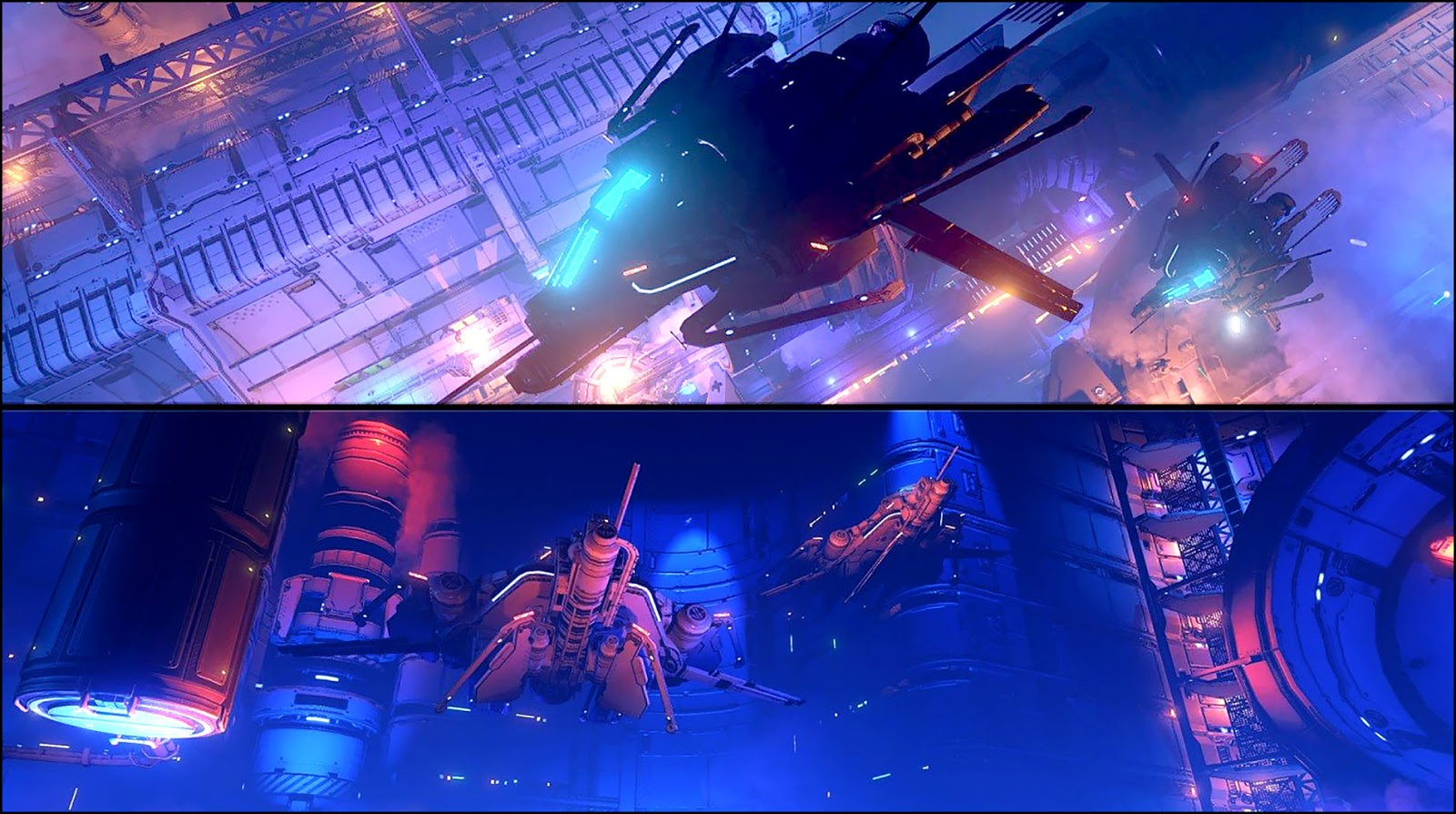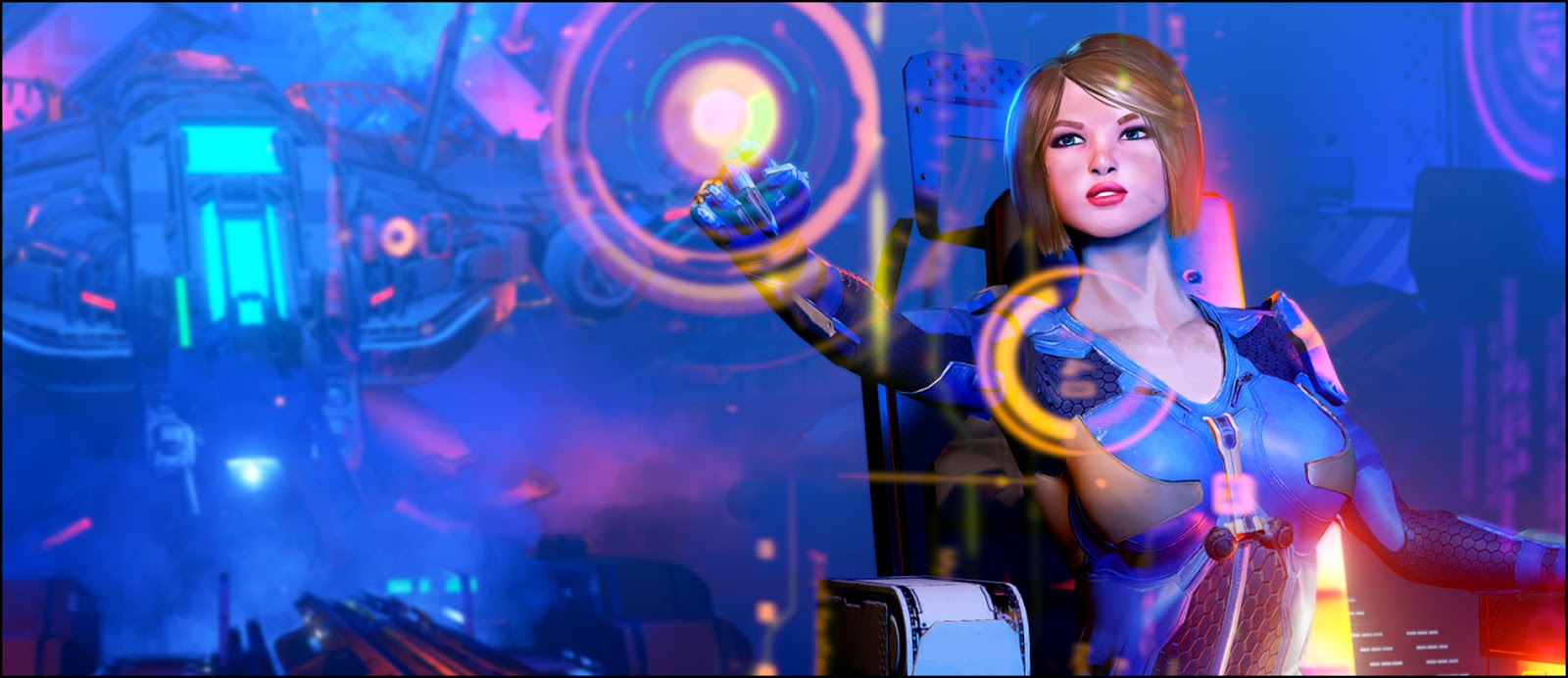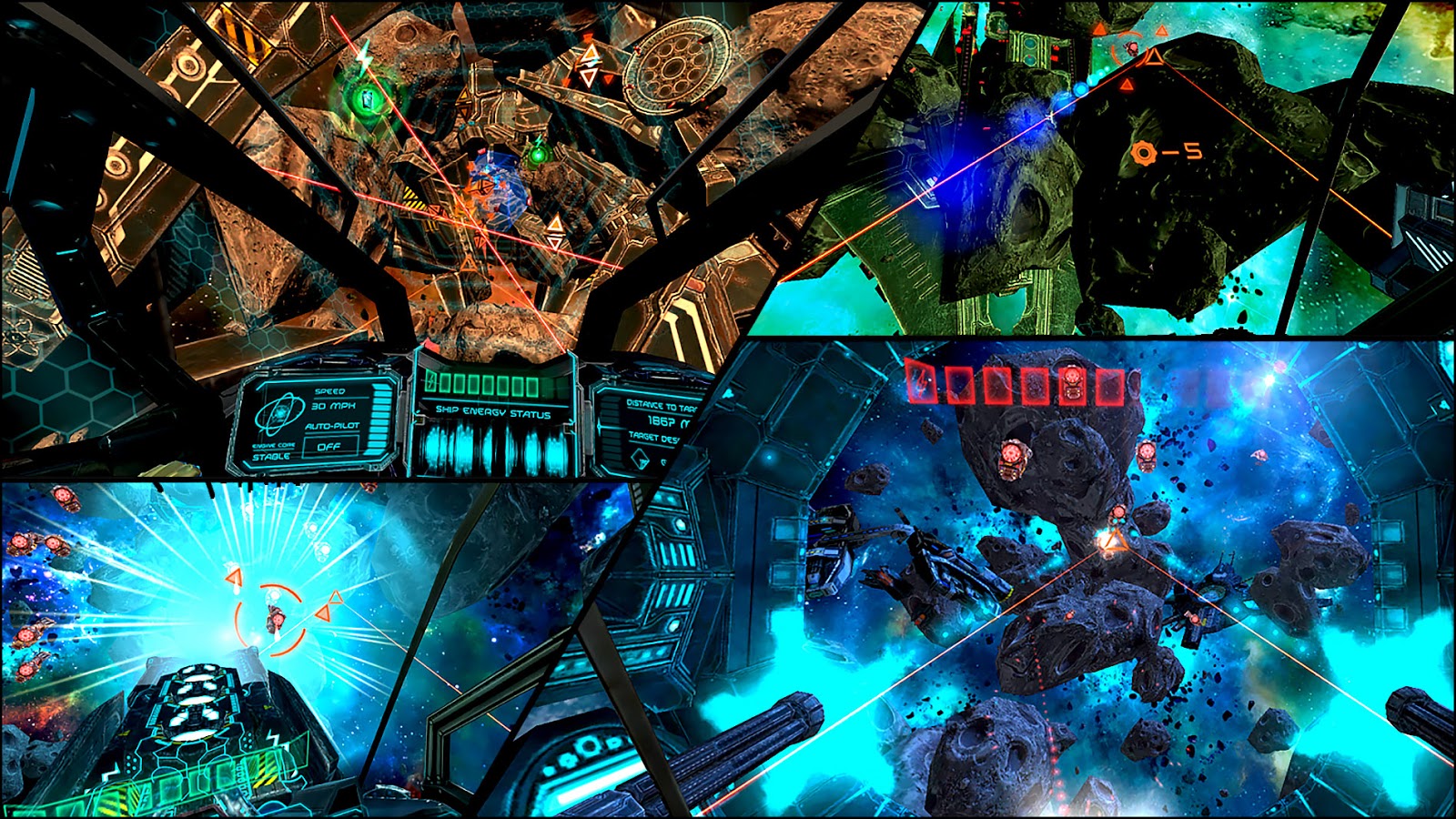How to publish the application in the Oculus Store and who needs it: the experience of Russian developers
Hello! We are from Fibrum . This is a Russian developer of software and hardware solutions in the mobile virtual reality market. Our partner, the LANIT group, invited Fibrum experts with their materials to this blog. And here we are!

In November 2016, we released Space Stalker - a game for mobile VR helmets. In preparation for publishing on Google Play and iOS, the team decided that it would be nice to release in the Samsung Gear VR store as well.
For a mobile VR game, Space Stalker has a rather diverse gameplay, a lot of game mechanics, high-quality production and a visual component. In essence, Space Stalker is a space shooter, the most familiar genre for gamers. The game fits perfectly into the product line, popular on the Samsung platform, both in the setting and in the game mechanics. Among other things, in Space Stalker you need to go through missions and shoot a lot, and in the Samsung helmet this is especially convenient to do with the touchpad (in the original Fibrum helmet, the control takes place with a look). The development was supposed to interest the audience of the Oculus Store. We, in turn, understood that the application would not be so difficult to adapt to the format of Gear VR, even in a short time.
Previously, Fibrum has already tried to publish its applications in the Oculus Store. But these were VR rides, the immersive effect of which was achieved due to the impact on the vestibular apparatus. Some were swayed, and for Samsung this is the main stop factor. The company takes first place the comfort of a person in a helmet and how much immersion in VR will be pleasant for him. The company has strict guidelines, according to which the games are assigned a certain level of comfort. Therefore, the rides, from which the head is spinning and you can lose balance (namely, for this effect, they are created), simply did not have a chance. Another thing - Space Stalker. He was eventually assigned a "yellow" (acceptable) level of comfort.
')

In general, Oculus Store guidelines include a number of points, starting with the content and ending with the design. For example, if your application consists of a small selection of 2D videos or is a “wrapper” for a plot of 360, then there is no chance of it being published. As for the design, when publishing it is worth paying special attention to it. Oculus logos can not be inserted anywhere, and the plate they will post after the review. The reverent attitude to the brand extends to publishers too. After successfully completing the review, Oculus Store will gladly publish your logos and screenshots. Of course, if they meet all the criteria (for this there is a separate guideline).
You should also pay attention to technical recommendations. Here are some of them:
These are just the most basic recommendations. There are a lot of them, and if you want to achieve the best immersive experience in VR, you should study the Oculus guidelines in detail. True, not all recommendations should be complied with without fail. Virtual reality is too young and unexplored area, so as not to experiment. Sometimes it is outside the rules that new cool solutions are born.

So, the basic version of the game was sent for review. Soon we received feedback, which in general was more than positive. It was necessary to take into account a number of comments, but a radical restructuring of the game was not required. It should be noted that all comments were on the case and helped to significantly improve the game. Therefore, in all the requirements of Samsung, we went to meet them. After the final version of the game was approved, Oculus Store clarified our plans for the release of the game. This gave every reason to hope that we will get into their update grid and will be placed in the Featured section (i.e. “Editor’s Choice” or “Recommended”, a huge banner on the store’s main page). At about the same time, the Oculus Connect 3 conference was held, during which our Space Stalker was shown on the Gear VR in the demo zone. The audience liked the game, so there was every reason to expect success after release.
In October, Space Stalker appeared in the Featured section of the Oculus Store. We stayed there for about a month, and during this time Space Stalker received fairly good coverage. For us, not only downloads were important, but also feedback. Despite many positive reviews, the Gear VR audience immediately demanded support from the controller. In this respect, it is much more sophisticated and demanding than users of cardboards or other mobile helmets. If Fibrum aims to make the experience in VR as simple as possible (put in a phone, put on a helmet and you're already in the game), then Samsung users, on the contrary, are used to having a controller in their hands, with which you can deal with enemies of the Universe.

In super-tight deadlines (in just 5 working days!) We completed the functionality and made an update with the support of the controller. It would seem that traffic should now grow and grow. However, after about a month, the period of stay on the main page of the store ended. From Featured, we hit Top Sales, then Just released, and finally got to the general store page. Now Space Stalker needed to be searched among the huge variety of all other applications, and the game’s visibility dropped to almost zero. Traffic also decreased tenfold. True, in December at the expense of Christmas, this figure increased slightly. This was largely due to the discount on the app: instead of $ 6.99 during the holidays, it cost only $ 1.99. However, in general, the stay in the Oculus Store can be described as follows: “Those who are in the top are for sale. And those who sell are in the top. ”
Therefore, if you are a developer who wants to sell his game at the Oculus Store, remember: their organic traffic is very weak. Users who enter the store have little interest in anything beyond the main page, and your application will still have to be further promoted.
Our PR included a standard distribution of press releases and PR in social networks. There were a lot of publications, even Space VR was written about Space Stalker. But in the case of Gear VR, this didn't help much. Apparently, you need to look for external channels to attract traffic. Especially if you do not want all efforts to adapt the game for the Oculus Store to be in vain.
Perhaps there is a second option - to stay in the top as long as possible at any cost. But what needs to be done for this, we still do not know, and if we find out, we will definitely share it in the next publications on Habré.
For help in creating the post many thanks daria_fibrum


In November 2016, we released Space Stalker - a game for mobile VR helmets. In preparation for publishing on Google Play and iOS, the team decided that it would be nice to release in the Samsung Gear VR store as well.
For a mobile VR game, Space Stalker has a rather diverse gameplay, a lot of game mechanics, high-quality production and a visual component. In essence, Space Stalker is a space shooter, the most familiar genre for gamers. The game fits perfectly into the product line, popular on the Samsung platform, both in the setting and in the game mechanics. Among other things, in Space Stalker you need to go through missions and shoot a lot, and in the Samsung helmet this is especially convenient to do with the touchpad (in the original Fibrum helmet, the control takes place with a look). The development was supposed to interest the audience of the Oculus Store. We, in turn, understood that the application would not be so difficult to adapt to the format of Gear VR, even in a short time.
Previously, Fibrum has already tried to publish its applications in the Oculus Store. But these were VR rides, the immersive effect of which was achieved due to the impact on the vestibular apparatus. Some were swayed, and for Samsung this is the main stop factor. The company takes first place the comfort of a person in a helmet and how much immersion in VR will be pleasant for him. The company has strict guidelines, according to which the games are assigned a certain level of comfort. Therefore, the rides, from which the head is spinning and you can lose balance (namely, for this effect, they are created), simply did not have a chance. Another thing - Space Stalker. He was eventually assigned a "yellow" (acceptable) level of comfort.
')

In general, Oculus Store guidelines include a number of points, starting with the content and ending with the design. For example, if your application consists of a small selection of 2D videos or is a “wrapper” for a plot of 360, then there is no chance of it being published. As for the design, when publishing it is worth paying special attention to it. Oculus logos can not be inserted anywhere, and the plate they will post after the review. The reverent attitude to the brand extends to publishers too. After successfully completing the review, Oculus Store will gladly publish your logos and screenshots. Of course, if they meet all the criteria (for this there is a separate guideline).
You should also pay attention to technical recommendations. Here are some of them:
- use only the optical distortion model that Oculus provides in its SDK and no other;
- the image must strictly correspond to the position of the head in the real world (for example, a 90 ° rotation in reality must correspond to the same rotation in VR);
- the image on each eye should differ only in the point of view and nothing else;
- VR experience should not be interrupted by anything (for example, a 2D picture), and the image should always respond to the rotation of the head;
- the application should work with the highest possible frame rate;
- Sharp manipulations with the camera (player's point of view) should be avoided, since rapid rotations and movements can cause motion sickness.
These are just the most basic recommendations. There are a lot of them, and if you want to achieve the best immersive experience in VR, you should study the Oculus guidelines in detail. True, not all recommendations should be complied with without fail. Virtual reality is too young and unexplored area, so as not to experiment. Sometimes it is outside the rules that new cool solutions are born.

So, the basic version of the game was sent for review. Soon we received feedback, which in general was more than positive. It was necessary to take into account a number of comments, but a radical restructuring of the game was not required. It should be noted that all comments were on the case and helped to significantly improve the game. Therefore, in all the requirements of Samsung, we went to meet them. After the final version of the game was approved, Oculus Store clarified our plans for the release of the game. This gave every reason to hope that we will get into their update grid and will be placed in the Featured section (i.e. “Editor’s Choice” or “Recommended”, a huge banner on the store’s main page). At about the same time, the Oculus Connect 3 conference was held, during which our Space Stalker was shown on the Gear VR in the demo zone. The audience liked the game, so there was every reason to expect success after release.
In October, Space Stalker appeared in the Featured section of the Oculus Store. We stayed there for about a month, and during this time Space Stalker received fairly good coverage. For us, not only downloads were important, but also feedback. Despite many positive reviews, the Gear VR audience immediately demanded support from the controller. In this respect, it is much more sophisticated and demanding than users of cardboards or other mobile helmets. If Fibrum aims to make the experience in VR as simple as possible (put in a phone, put on a helmet and you're already in the game), then Samsung users, on the contrary, are used to having a controller in their hands, with which you can deal with enemies of the Universe.

In super-tight deadlines (in just 5 working days!) We completed the functionality and made an update with the support of the controller. It would seem that traffic should now grow and grow. However, after about a month, the period of stay on the main page of the store ended. From Featured, we hit Top Sales, then Just released, and finally got to the general store page. Now Space Stalker needed to be searched among the huge variety of all other applications, and the game’s visibility dropped to almost zero. Traffic also decreased tenfold. True, in December at the expense of Christmas, this figure increased slightly. This was largely due to the discount on the app: instead of $ 6.99 during the holidays, it cost only $ 1.99. However, in general, the stay in the Oculus Store can be described as follows: “Those who are in the top are for sale. And those who sell are in the top. ”
Therefore, if you are a developer who wants to sell his game at the Oculus Store, remember: their organic traffic is very weak. Users who enter the store have little interest in anything beyond the main page, and your application will still have to be further promoted.
Our PR included a standard distribution of press releases and PR in social networks. There were a lot of publications, even Space VR was written about Space Stalker. But in the case of Gear VR, this didn't help much. Apparently, you need to look for external channels to attract traffic. Especially if you do not want all efforts to adapt the game for the Oculus Store to be in vain.
Perhaps there is a second option - to stay in the top as long as possible at any cost. But what needs to be done for this, we still do not know, and if we find out, we will definitely share it in the next publications on Habré.
For help in creating the post many thanks daria_fibrum

Source: https://habr.com/ru/post/321958/
All Articles